
Vertical splits in trees, also known as tree cracks, can be a serious concern for any tree owner or landscaper in O’Fallon, IL. These splits can not only be unsightly but also pose significant risks to the tree’s health and stability. In this blog, we will explore what causes vertical splits, how to assess their severity, and what can be done to manage or repair them.
Understanding Vertical Splits in Trees
Vertical splits can occur in a tree’s trunk or larger branches and typically run along the grain of the wood. They can vary in length and depth, sometimes extending deep into the core of the tree. There are several reasons why a tree might develop vertical splits:
- Temperature Fluctuations: Extreme and rapid temperature changes can cause the wood to expand and contract, which may lead to splitting. This is particularly common in climates where there are sharp temperature swings between day and night.
- Mechanical Damage: Damage from landscaping equipment, vehicles, or improper pruning can weaken the tree structure, leading to splits.
- Internal Stresses: As trees grow and age, internal stresses can develop due to asymmetric growth, previous injuries, or improper care, resulting in splits.
- Infections and Pests: Certain diseases and pests can weaken the wood, making it more susceptible to cracking.
Assessing the Severity of a Split
The impact of a vertical split depends on its location, size, and the overall health of the tree. Minor splits may not pose a significant threat, especially if the tree is otherwise healthy and vigorous. However, large, or deep splits can compromise the structural integrity of the tree, making it a hazard, especially during high winds or storms.
To properly assess a split, consider the following:
- Width and Depth: Wider and deeper splits are more dangerous.
- Location: Splits at critical points, such as the junction of major branches or near the base of the trunk, are more concerning.
- Signs of Decay: Dark discoloration, a foul odor, or soft, crumbly wood around the split can indicate decay, which worsens the situation.

Managing and Repairing Splits
- Proper Assessment: Consulting with a certified arborist is crucial. They can provide a detailed risk assessment and recommend appropriate actions based on the tree’s condition and the severity of the split.
- Cable Bracing and Support: For trees with significant value and manageable splits, arborists might install cables or braces to reduce stress on the split area and help stabilize the tree. This method doesn’t repair the split but can prevent further damage and extend the tree’s life.
- Pruning: Removing damaged or heavy branches can reduce the weight on the split area, alleviating stress and preventing further cracking.
- Wound Care: While it once was common to fill splits with cement or paint over them, research suggests these methods can hinder the tree’s natural healing process. Instead, maintaining good tree health and protecting the tree from further stress is recommended.
- Tree Removal: In cases where the splitting severely compromises the tree’s stability, or if it poses a danger to people or property, removal might be the only safe option. Ask a tree expert near O’Fallon, IL.
Get a tree inspection to determine what services are needed in O’Fallon, IL. Call Merritt’s Tree Service today for more information.